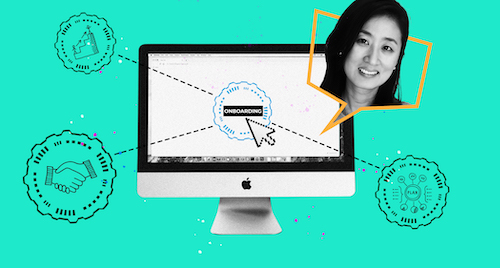Human Resources Management Associate Professor Junghyun (Jessie) Lee said with workplace shifts due to the pandemic, Smith’s apprehension about starting somewhere new while in a virtual environment has become a more common experience. The good news? These concerns can be alleviated through intentional actions and onboarding best practices.
“If you show new hires that you value them and want to help them grow their network and talents, they will want to stay with your organization.”
Lee, a researcher on workplace organization and social exchange relationships, shares a few tips leaders can use to set new employees — and the team — up for success.
Give an official welcome.
As many workplaces shift to a permanent work-from-home model or a hybrid version of it, onboarding best practices are increasingly important in talent cultivation and retention. So start off right.
After a job offer is accepted, send a welcome package or welcome email. Lee said this should include a welcome letter, company handbook, a first-day schedule, how to obtain office equipment, and a way to contact their supervisor if there are questions. If there is a budget for it, sending company-branded swag or a gift card to use for a first-day virtual coffee chat can help new hires to feel connected and valued.
But she cautions that onboarding from start to finish shouldn’t just be the job of the supervisor. “A good onboarding process takes time and effort. It’s important to partner with human resources for support. People need to work together to give new hires a good experience — it’s not one individual's job.”
Clarity is key.
In any relationship, people want to know where they stand. Lee said that’s why — especially in a virtual environment where people can’t pick up on body language or inter-office cues — it’s good to be direct and clear. Lee said to plan regular onboarding check-ins for up to a year. “People want to know what is expected of them, how their performance will be reviewed, if they are doing their job well, and if there are skill gaps that need to be addressed. Blocking off time to regularly check-in provides an avenue for communication and connection." Those set check-ins also can serve as a time to talk about goals, compensation and benefits and job satisfaction. If an organization cannot dedicate a year, strongly consider at least three months."
Paying attention to new hires is crucial. You don’t want new hires to feel overlooked. They will leave.” Survey findings suggest about a half of new hires leave within the first 90 days and that companies with a standard onboarding process have up an 82% higher retention rate than places that don’t.
Designate a buddy or two.
The digital part of remote work isn’t complicated — it’s the people and culture that can be difficult for someone new to navigate. To help with this, Lee says it’s good to match a new hire with a seasoned employee who is not a supervisor through an onboarding buddy program. Lee said workplaces should consider pairing people with someone inside of the team and with someone in another department who could connect the employee to additional information networks within the organization. According to the Human Capital Institute, 87% of workplaces that have a buddy program during the onboarding process said it's an effective way to speed up new hire proficiency too.
Place resources in a centralized digital office.
Team spaces are important when facilitating and nurturing innovation and collaboration, Lee said. So it’s a good idea to create a central cloud-based location for office items like team tools and tutorials, a digital whiteboard for idea collaboration, a catch-up space people can go to if they missed a meeting, and a calendar for upcoming projects or events. “It’s an overall good practice for remote work and it gives new hires a place they can go to learn more about the work the team is involved with and keep up-to-date.”
Keep facilitating social connection.
Lee said data has shown for years that workplace social connection is important to success and happiness — but now it’s viewed as critical. To help people get to know colleagues, Lee suggests much of what new UM-Dearborn hire Cameron Smith experienced: small group or one-on-one meetings, scheduling time on a team meeting agenda to talk about personal accomplishments (if people want to share), and virtual happy hours. With vaccine distribution and warm weather on the horizon, there may be opportunities for masked in-person contact like team lunches in the park or a neighborhood walk for people who are near one another. Leaders can also ask employees if they have ideas on how to welcome new people onto the team.
“Things aren’t going to be the same as what we had before and that’s ok,” Lee said. “In the past, coworkers worked together for many years and never saw the inside of each other’s home or met each other’s family or pets. Now we see a personal side of someone’s life right away — that’s a good starting point for building interpersonal relationships. There are many ways we can connect and welcome new employees, we just need to think a little differently and be more intentional.”
Interview by Sarah Tuxbury. If you’re a member of the media and would like to interview Associate Professor Junghyun (Jessie) Lee about this topic, please drop us a line at UMDearborn-News@umich.edu.





